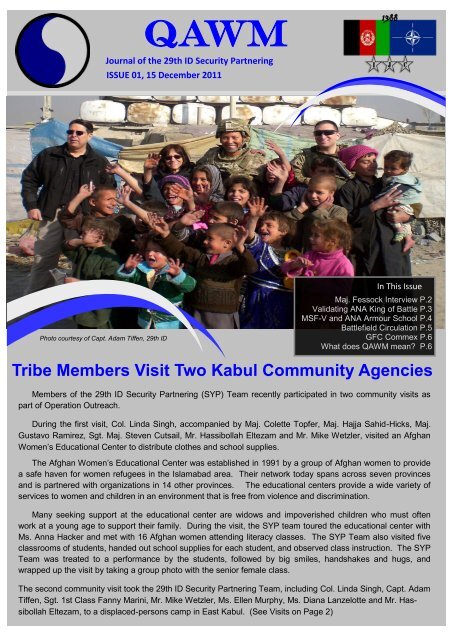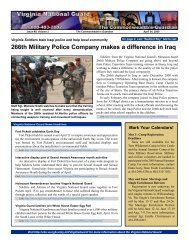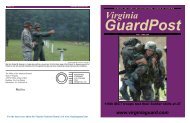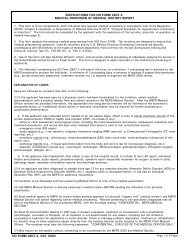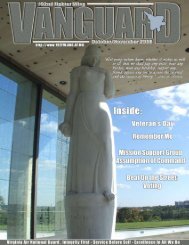QAWM
Issue 1
Issue 1
- No tags were found...
Create successful ePaper yourself
Turn your PDF publications into a flip-book with our unique Google optimized e-Paper software.
<strong>QAWM</strong><br />
Journal of the 29th ID Security Partnering<br />
ISSUE 01, 15 December 2011<br />
Photo courtesy of Capt. Adam Tiffen, 29th ID<br />
In This Issue<br />
Maj. Fessock Interview P.2<br />
Validating ANA King of Battle P.3<br />
MSF-V and ANA Armour School P.4<br />
Battlefield Circulation P.5<br />
GFC Commex P.6<br />
What does <strong>QAWM</strong> mean? P.6<br />
Tribe Members Visit Two Kabul Community Agencies<br />
Members of the 29th ID Security Partnering (SYP) Team recently participated in two community visits as<br />
part of Operation Outreach.<br />
During the first visit, Col. Linda Singh, accompanied by Maj. Colette Topfer, Maj. Hajja Sahid-Hicks, Maj.<br />
Gustavo Ramirez, Sgt. Maj. Steven Cutsail, Mr. Hassibollah Eltezam and Mr. Mike Wetzler, visited an Afghan<br />
Women‟s Educational Center to distribute clothes and school supplies.<br />
The Afghan Women‟s Educational Center was established in 1991 by a group of Afghan women to provide<br />
a safe haven for women refugees in the Islamabad area. Their network today spans across seven provinces<br />
and is partnered with organizations in 14 other provinces. The educational centers provide a wide variety of<br />
services to women and children in an environment that is free from violence and discrimination.<br />
Many seeking support at the educational center are widows and impoverished children who must often<br />
work at a young age to support their family. During the visit, the SYP team toured the educational center with<br />
Ms. Anna Hacker and met with 16 Afghan women attending literacy classes. The SYP Team also visited five<br />
classrooms of students, handed out school supplies for each student, and observed class instruction. The SYP<br />
Team was treated to a performance by the students, followed by big smiles, handshakes and hugs, and<br />
wrapped up the visit by taking a group photo with the senior female class.<br />
The second community visit took the 29th ID Security Partnering Team, including Col. Linda Singh, Capt. Adam<br />
Tiffen, Sgt. 1st Class Fanny Marini, Mr. Mike Wetzler, Ms. Ellen Murphy, Ms. Diana Lanzelotte and Mr. Hassibollah<br />
Eltezam, to a displaced-persons camp in East Kabul. (See Visits on Page 2)
Photo left: 29th ID SYP Team<br />
members visit The Afghan<br />
Women’s Educational Center 6<br />
Dec. in Kabul, Afghanistan.<br />
Photo courtesy of Maj. Hajja<br />
Sahid-Hicks, 29th ID SYP.<br />
Visits from page 1<br />
The families living there are<br />
largely Pashtun refugees.<br />
These families live in makeshift<br />
tents, have no access to<br />
clean water and use whatever<br />
resources they can to support<br />
themselves. While these<br />
families have little, they were<br />
in high spirits and very excited<br />
by the visit of the SYP Team.<br />
The SYP Team distributed warm clothing, blankets, and dozens of pairs of shoes, sneakers, and boots. The<br />
children patiently lined up to receive their shoes, coats, hats, and toys, and were very inquisitive about their visitors.<br />
They were also very excited by the handouts of chocolate and candy, and shrieked with delight when<br />
handfuls of candy were thrown into the air for them to catch. It was a very rewarding experience for the SYP<br />
Team to see the children clutching a new pair of shoes or a woolen hat, and knowing that the donations will help<br />
make their lives a little easier during the difficult winter ahead. For more information visit www.awec.info.<br />
Interview with Maj. Robert Fessock, 29th ID SYP, Kabul City Police LNO<br />
Hometown/College: South Plainfield, NJ/Towson University Graduate<br />
Civilian Occupation: Washington D.C. Police Officer<br />
Time in Service: 12 years<br />
Q: As a 29th SYP Police LNO, what is your mission at Kabul City Police Center<br />
(KCPC)?<br />
A: My duties include work with counter-narcotics, kidnapping investigations, and<br />
police operations teams in the KCPC . My major objectives include standardizing<br />
and improving evidence collection and processing, narcotics seizures, and basic<br />
police report writing.<br />
Q: What is the best part of your job at KCPC?<br />
A: I enjoy the opportunity to work with other Services like the Navy and Air Force,<br />
and working with special units of the Afghan National Police (ANP). Every day is a learning experience in this duty<br />
position.<br />
Q: What do you miss most about home?<br />
A: I miss my children, family, and friends the most, but also the sense of security that we take for granted at home.<br />
I hope we can help our Afghan partners build a lasting secure environment here in Kabul.<br />
Q: How does your civilian occupation and experience help in the duties at KCPC?<br />
A: The training, education, and experiences in the DCPD gives me a solid foundation of law enforcement to mentor<br />
and assist the police officers of KCPC.<br />
Q. What do you hope are some outcomes at KCPC as a result of your deployment?<br />
A: The hope is that all of our efforts lead to a safer community here in Afghanistan with a professional police force<br />
protecting the citizens of Kabul.
29th SYP Artillerymen Validate ANA Tolay at Pol-e-Charki<br />
Sgt. 1st Class Russell Myers<br />
and Maj. Nat Williams, artillerymen<br />
from the 29th ID Security Partnering<br />
Team, assisted the Validation Transition<br />
Team (VTT) in the final<br />
evaluation of the combat support<br />
(CS) kandak (battalion) for the 3rd<br />
Brigade, 201st "Sylab" Corps of the<br />
Afghan National Army (ANA). The<br />
four-day exercise began 1 Dec at<br />
the ANA training area at Pol-e-<br />
Charki, just outside of Kabul City.<br />
The VTT assessed the CS Kandak<br />
during a situational tactical exercise<br />
that included survivability tasks,<br />
route and zone reconnaissance,<br />
artillery support, and tactical reporting.<br />
The validation team evaluated<br />
20 tasks from the ANA Mission<br />
Training Plans (MTPs), utilizing task<br />
checklists from the Training and<br />
Evaluation Outlines (T&EOs).<br />
Combat support kandaks in the<br />
ANA consist of a reconnaissance<br />
coy (company), an engineer coy, an<br />
artillery tolay (battery) and a fourth<br />
coy, consisting of a signal platoon,<br />
a fire support platoon, and other<br />
combat service support assets.<br />
Kandak leaders developed a<br />
plan using the military decision<br />
making process (MDMP), delivered<br />
the operational plan (OPLAN) to<br />
their subordinate coys, then rehearsed<br />
and executed their mission.<br />
On the final day of the exercise,<br />
all elements of the combat<br />
Photos on this page by Sgt. 1st Class Russell<br />
Myers<br />
support (CS) kandak were evaluated<br />
individually and collectively on<br />
their ability to properly execute the<br />
commander‟s OPLAN. The unit<br />
moved from their staging areas to<br />
the remains of an old Soviet base.<br />
This location served as the forward<br />
operating base for the kandak and<br />
the fire base for the artillery tolay.<br />
After a morning full of activity<br />
testing the kandak‟s other units‟<br />
abilities to execute the commander's<br />
OPLAN, the very eager<br />
firing element was ready to perform.<br />
The tolay recently fielded four D30<br />
122mm towed howitzers and a coalition<br />
team of officers and Non Commissioned<br />
Officers (NCOs) from<br />
Croatia and France mentored the<br />
unit through training and validation.<br />
Sgt. 1st Class Myers and Maj.<br />
Williams evaluated the artillery in<br />
the areas on gunnery and fire support.<br />
The tolay quickly moved into<br />
their position and prepared the howitzers<br />
and fire direction center<br />
(FDC) for action. Concurrently, the<br />
forward observers accompanied the<br />
reconnaissance elements to the forward<br />
observation post as the tolay<br />
was continuing position improvement<br />
within their fire base. Just as<br />
the action began to build to a crescendo,<br />
a safety delay from elements<br />
not in training caused the<br />
entire operation to halt. As with artillery<br />
training anywhere in the<br />
world; safety is paramount. After<br />
this short delay, the tolay<br />
commander received the callfor-fire<br />
from the forward observers.<br />
The FDC and gun<br />
line moved in a coordinated<br />
and synchronized exercise<br />
familiar to any artilleryman,<br />
and the fire mission began.<br />
When the smoke cleared, the<br />
tolay had engaged and destroyed<br />
their target, thus validating<br />
their ability to mass<br />
fires.<br />
By the end of the day, the<br />
tolay demonstrated that they<br />
could perform the basic tasks<br />
that any artillery unit in the<br />
world must be able to do;<br />
"shoot, move and communicate".<br />
The unit performed all<br />
artillery tasks proficiently and<br />
professionally, while displaying<br />
a level of discipline which<br />
shall serve them and their<br />
command well in the future<br />
performance of their mission.<br />
The evaluation was declared<br />
a success, and the CS Kandak<br />
of 3rd Bde, 1st Corp was<br />
deemed validated and ready<br />
to join the fight.
Mobile Strike Force Vehicles<br />
SYP FUPLANS members coordinate with NTM-A for<br />
fielding and training of this critical asset.<br />
Members of the 29th ID Security<br />
Partnering Team, Future Plans-<br />
ANA development cell met with<br />
their NATO Training Mission-<br />
Afghanistan (NTM-A) partners Dec.<br />
4 at Camp Blackhorse, located<br />
within the Pol-e-Charki ANA military<br />
complex on the eastern edge<br />
of Kabul. Col. Stuart Mellon, Maj.<br />
Jared Lake, Maj. Michael Mussio,<br />
Maj. John Martin, and other IJC<br />
members were there to coordinate<br />
with the NTM-A Branch School<br />
Campaign Transition and Assessments<br />
Group„s (CTAG) training<br />
plans and capacity in order to integrate<br />
IJC‟s efforts to receive, support,<br />
and mentor the new units<br />
once they are fielded.<br />
The visit began with a briefing<br />
by the NTM-A Branch School<br />
CTAG leadership outlining the<br />
training program and requirements.<br />
Key discussions focused on transition<br />
to IJC control and how to tailor<br />
the training program to tactical realities<br />
in the field. Following the<br />
briefing, the SYP team traveled to<br />
the site of the temporary armour<br />
branch school in Pol-e-Charki compound.<br />
Touring the facilities, the<br />
team received an orientation of the<br />
training program<br />
and resources.<br />
Finally, the team<br />
received an orientation<br />
of the training<br />
area in which<br />
the MSF Kandaks<br />
will maneuver for<br />
their critical validation<br />
training with<br />
t h e ir advisor<br />
teams just prior to<br />
fielding.<br />
The SYP continues<br />
to fulfill its mission of coordinating<br />
across the IJC to ensure that<br />
the development of the Afghan National<br />
Security Forces meets the<br />
needs of the coalition and the government<br />
of the Islamic Republic of<br />
Afghanistan. By getting on the<br />
ground “where the rubber meets the<br />
road” the SYP team ensures our<br />
planning efforts are “Making it Matter.”<br />
A mobile strike force vehicle (MSF-V ) (left)<br />
scheduled for fielding to the ANA is pictured<br />
beside the Armored Security Vehicle (ASV).<br />
Barker Promotion<br />
Security Partnering Director Brig.<br />
Gen. Charles W. Whittington Jr.,<br />
promotes Capt. Douglas Barker,<br />
a 29th ID SYP member, and FU-<br />
OPS ABP Planner, to major at<br />
IJC HQs.<br />
Silberman Promotion<br />
Security Partnering Director Brig.<br />
Gen. Charles W. Whittington Jr.,<br />
promotes Capt. Michael Silberman,<br />
a 29th ID SYP member and<br />
National Police Coordination<br />
Center Watch-keeper, to major at<br />
ISAF HQ.
Members of the 29th ID Security<br />
Partnering team travelled to Mazar-e-<br />
Sharif Nov. 29 to conduct key leader<br />
engagements with personnel from Regional<br />
Command North (RC-N). The<br />
team, led by Security Partnering Director<br />
Brig. Gen. Charles W. Whittington,<br />
Jr., met with primary Afghan National<br />
Security Force (ANSF) growth and development<br />
stakeholders in the region<br />
to gain a better understanding of their<br />
operations, discuss immediate and<br />
long-term issues and to identify areas<br />
where International Security Assistance<br />
Force Joint Command (IJC) and<br />
the RC-North Afghan National Security<br />
Force (ANSF) leadership can better<br />
synchronize efforts and communication<br />
to advance ANSF growth and development.<br />
Brig. Gen. Amanulla Mubin, 209 th<br />
Corps deputy commander, the senior<br />
Afghan National Army (ANA) representative<br />
present during the meetings,<br />
was joined by Hungarian Brig. Gen.<br />
Laszlo Szabo, RC-North chief of staff.<br />
Other key representatives included<br />
senior level Afghan development advisors<br />
and Operational Mentor Liaison<br />
Team (OMLT) leaders. The Security<br />
Battlefield Circulation<br />
29th ID Security Partnering Visits Mazar-e-Sharif<br />
29th ID SYP Director Brig. Gen. Charles W. Whittington, Jr., (right), meets with Brig. Gen.<br />
Amanullah Mubin, Deputy Commander of the Afghan National Army 209th Corps and Col.<br />
Walter Schulte, Senior Mentor during a visit to Mazar-e-Sharif. Photo: Capt. Adam Tiffen<br />
Partnering team included Fusion<br />
Cell Director Lt. Col. Charles<br />
Blomquist, Senior Enlisted Advisor<br />
Sgt. Maj. Christopher Brock,<br />
ANSF Field Assessment Analyst<br />
Maj. Colette Topfer, and Capt.<br />
Adam Tiffen, aide de camp to the<br />
director.<br />
The successful leader engagements<br />
addressed ANA infra-<br />
COMGFC and 29th ID Security Partnering GFC Visits Jalalabad<br />
structure issues, future manning<br />
projections, assessment<br />
metrics, and a way ahead on<br />
future contracted and OMLT<br />
mentoring relationships. Immediate<br />
impacts were made<br />
to improve ANA equipment<br />
fielding and leaders were<br />
able to identify areas to increase<br />
manning effectiveness<br />
throughout the region.<br />
Thirty members of the Afghan<br />
Ground Forces Command (GFC)<br />
and their embedded advisors, to include<br />
seven members from the 29th<br />
ID SYP, conducted the first Commander<br />
Ground Forces Command<br />
(COMGFC) battlefield circulation trip<br />
29 Nov. to Jalalabad, Afghanistan.<br />
Col. Lapthe Flora, Lt. Col. Doug<br />
Gagnon, Lt. Col. Dan Austin, Lt. Col.<br />
Lance Newby, Maj. Clay Allison,<br />
Capt. Sam Kimzey, and Capt. Keith<br />
Moran accompanied the COMGFC<br />
on two ANA Air Corps Mi17 helicopters<br />
to visit the 201st Corps area of<br />
operations.<br />
The trip objectives included a<br />
survey of the corps‟ status and<br />
readiness, meeting with counterparts,<br />
and to view the layout of<br />
the ANA 201st Corps Joint Operations<br />
Center (JOC). The JOC<br />
is nearly identical to the GFC<br />
JOC, currently under construction.<br />
The visit started with a redcarpet<br />
welcome at the helicopter<br />
pad by the leadership of the<br />
201st and Soldiers in full dress<br />
uniform. Next, the corps commander<br />
briefed the GFC leadership<br />
on subordinate unit locations<br />
and highlighted unit challenges<br />
and successes. The visitors<br />
GFC during their visit to Mazar-e-Sharif<br />
Nov 29. Photo courtesy of Lt. Col. Robert<br />
Frick, 29th ID SYP<br />
toured a medical facility and<br />
met with senior leadership<br />
from 1st Brigade, which is colocated<br />
with the corps headquarters.<br />
The visit concluded<br />
with a meal shortly before an<br />
early afternoon departure.
GFC Conducts First<br />
COMMEX<br />
The Afghan Ground Forces Command<br />
(GFC) successfully completed a five-day<br />
communications exercise (COMMEX) Nov<br />
23. The GFC conducted the exercise early<br />
in their train-up period, working towards<br />
the July 2012 goal of full operational capability.<br />
Once fully operational, GFC, a threestar<br />
level command, will serve as the command<br />
and control for the six Afghan corps<br />
and other subordinate units. The unit recently<br />
activated, received computers in<br />
August 2011 and organized a temporary<br />
Joint Operations Center (JOC) in September<br />
2011. The COMMEX displayed the<br />
robust, reliable, and redundant communication<br />
capability essential for efficient command<br />
of subordinate units.<br />
During the COMMEX, GFC staff<br />
sections communicated with subordinate<br />
unit counterparts and their Ministry of Defense<br />
counterparts using the PBX phone<br />
system, cell phones, and by email. The<br />
GFC G3 consolidated all contact information<br />
for development of phone books and<br />
email directories. Additionally, the commands<br />
communicated using the RT-7000<br />
tactical high frequency radio system and<br />
GFC staff sections shared documents internally<br />
using the command‟s networked<br />
share drive. The GFC members conducted<br />
the exercise in the JOC where the<br />
vast majority of networked computers and<br />
phones exist. By the end of the exercise,<br />
the participants met all of the objectives<br />
which both proved the capability of communication<br />
systems and bolstered the<br />
GFC‟s confidence to reach out to outside<br />
organizations.<br />
Lt. Gen. Murad Ali Murad, COMGFC, participates in the recent GFC COMMEX<br />
conducted in the Joint Operation Center. Photo courtesy of Lt. Col. Robert Frick.<br />
What does <strong>QAWM</strong> mean?<br />
Qawm is an Arabic term used in Afghanistan to refer<br />
to any form of solidarity. It may be based on kinship,<br />
residence or occupation. It is sometimes referred<br />
to as one‟s “tribe.”<br />
Afghans identify themselves by qawm, rather than<br />
by tribe or nationality. One's qawm identity is based on<br />
kinship, residence, and sometimes occupation. Although<br />
"qawm" is sometimes translated into English as<br />
"tribe," the qawm relationship may cross tribal or even<br />
ethnic boundaries. The qawm is the basic unit of social<br />
community in Afghanistan, which has added to the<br />
challenge of creating a national identity in that nation.<br />
A qawm is typically governed by jirga or shura (a council<br />
or assembly of elder males).<br />
<strong>QAWM</strong><br />
ISSUE 01<br />
15 December 2011<br />
29th Infantry Division, Security Partnering<br />
NKAIA-IJC-SYP<br />
APO, AE 09320


